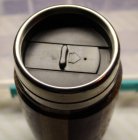I sure hope someone out there can help me.....
I've been trying to make a travel mug from wood, having purchased the stainless steel insert and downloaded plans from Woodcraft. I've laminated oak and red heart to create a block 5" X 8" and turned it round on the lathe, creating a tenon on one end to hold my piece into the chuck.
My problem? Whenever I try to hollow out the 5-1/8" from the inside of the vessel, the chuck jaws do not hold the piece and it flies off. I have an exterior holding device but it's jaws are maximum of 3" (I used it to turn canes in a previous life) and the project that I'm working with now is 3-1/2"
How can I hold this piece properly on the lathe so that it spins true and doesn't fly off? I'm exasperated....
BTW, my experience on a lathe is minimal, I work at a Senior Centre with their lathe and chucks, but I do use my own chisels, preferring my Robert Sorby tools to those in our shop. I'm not against being another device to assist holding my project at the tailstock area while I hollow it out.
Suggestions? Ideas? Videos?
Thanks.
I've been trying to make a travel mug from wood, having purchased the stainless steel insert and downloaded plans from Woodcraft. I've laminated oak and red heart to create a block 5" X 8" and turned it round on the lathe, creating a tenon on one end to hold my piece into the chuck.
My problem? Whenever I try to hollow out the 5-1/8" from the inside of the vessel, the chuck jaws do not hold the piece and it flies off. I have an exterior holding device but it's jaws are maximum of 3" (I used it to turn canes in a previous life) and the project that I'm working with now is 3-1/2"
How can I hold this piece properly on the lathe so that it spins true and doesn't fly off? I'm exasperated....
BTW, my experience on a lathe is minimal, I work at a Senior Centre with their lathe and chucks, but I do use my own chisels, preferring my Robert Sorby tools to those in our shop. I'm not against being another device to assist holding my project at the tailstock area while I hollow it out.
Suggestions? Ideas? Videos?
Thanks.






